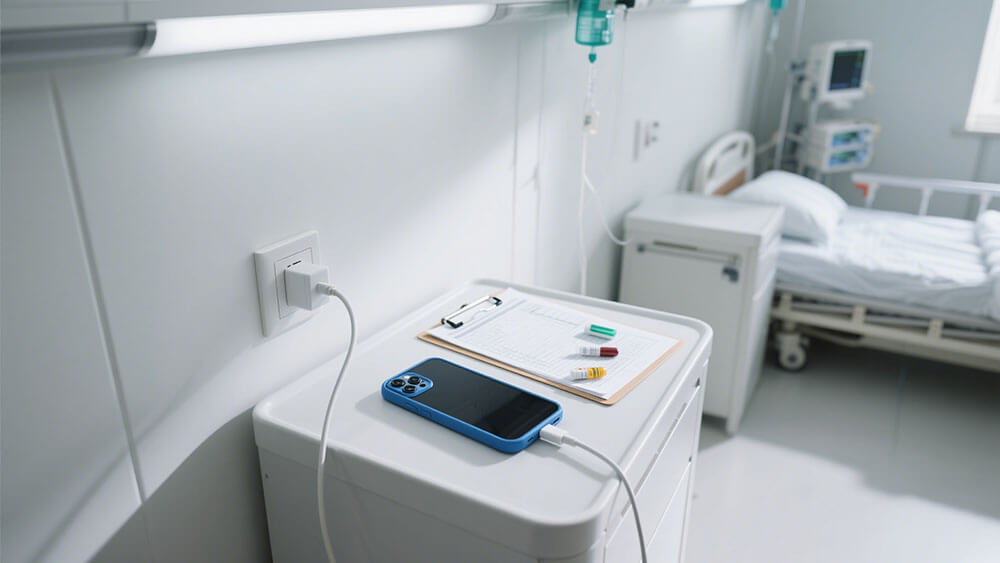
Understanding the concept of battery cycle count is essential for evaluating battery performance and longevity. A cycle count measures the number of complete charge and discharge cycles a battery undergoes during its lifespan. This metric directly influences how long the battery can reliably function. For industrial and commercial systems, optimizing cycle count can significantly reduce operational costs and downtime.
Studies reveal that dynamic cycling increases battery lifetime by up to 38% compared to constant current cycling. Maintaining a C-rate between 0.3C and 0.5C strikes a balance between time-induced and cycling-induced aging, ensuring optimal performance over time.
By mastering the relationship between cycle count and service life, you can extend battery efficiency and ensure smoother operations.
Key Takeaways
Knowing cycle count helps predict battery life and plan replacements. Checking it often prevents sudden battery failure.
Using partial discharges and keeping batteries cool makes them last longer. These steps lower damage to the battery.
Smart tools and data analysis improve battery care. They give live updates, helping with quick fixes and better use.
Part 1: What Is Battery Cycle Count and How Does It Work?

1.1 Defining Battery Cycle Count
Battery cycle count refers to the number of complete charge and discharge cycles a battery undergoes during its operational life. A single cycle is completed when the battery discharges 100% of its capacity, regardless of whether this occurs in one continuous use or over multiple partial discharges. For example, if a battery discharges 50% one day and another 50% the next, it counts as one full cycle.
Understanding this metric is crucial for industries relying on lithium-ion batteries, such as medical devices, robotics, and infrastructure systems. These applications demand consistent performance and reliability, making cycle count a key indicator of battery health. By tracking cycle count, you can predict when a battery might reach the end of its service life and plan replacements proactively.
Tip: Regularly monitoring cycle count helps you avoid unexpected downtime and ensures optimal performance in critical systems like security networks or transportation infrastructure.
1.2 How Battery Cycle Count Is Measured in Industrial Systems
Measuring battery cycle count in industrial systems requires precision and consistency. The process involves tracking the cumulative charge and discharge cycles under controlled conditions. To ensure accuracy, you must consider several factors:
Consistent Testing Conditions: Maintain uniform temperature and load conditions during testing to reduce variability.
Calibrated Equipment: Use properly calibrated measurement tools to minimize errors.
Addressing Uncertainties: Account for potential issues such as mismatched test channels, temperature fluctuations, and cell polarization, which can distort results.
Industrial systems often employ advanced algorithms and machine learning models to enhance measurement accuracy. For instance, studies have shown that methods like LSTM neural networks and CNN-LSTM models improve predictions of battery health indicators as cycles increase. The table below highlights some methodologies used in industrial applications:
These methodologies are particularly valuable in industries like consumer electronics and industrial automation, where precise battery monitoring is essential for maintaining efficiency and safety.
1.3 Why Battery Cycle Count Is Critical for Service Life
The relationship between cycle count and service life is direct and significant. Each charge and discharge cycle contributes to the gradual degradation of a battery’s capacity and performance. Over time, this degradation reduces the battery’s ability to hold a charge, ultimately shortening its service life.
For lithium-ion batteries, the chemistry plays a pivotal role in determining cycle life. For instance:
LiFePO4 Lithium batteries offer a cycle life of 2,000 to 5,000 cycles, making them ideal for long-term applications like infrastructure and robotics.
NMC Lithium batteries provide 1,000 to 2,000 cycles, balancing energy density and longevity for consumer electronics and medical devices.
By understanding the relationship between cycle count and service life, you can implement strategies to extend battery health. For example, avoiding deep discharges and maintaining moderate charge levels can significantly reduce wear and tear on the battery. This approach is particularly beneficial for industries like security systems, where uninterrupted power is critical.
Note: Sustainable battery management not only extends service life but also aligns with global sustainability goals. Learn more about sustainable practices here.
Part 2: The Relationship Between Cycle Count and Service Life

2.1 How Cycle Count Impacts Battery Degradation
Every charge and discharge cycle contributes to the gradual degradation of a battery. This process occurs due to chemical and physical changes within the battery’s components. Over time, these changes reduce the battery’s capacity to store energy and deliver consistent performance. For lithium-ion batteries, degradation often manifests as capacity fade and increased internal resistance, which directly impacts battery health.
The rate of degradation depends on how the battery is used. For example, frequent deep discharges or high charging rates accelerate wear and tear. In industrial applications, such as robotics, where batteries undergo continuous cycling, monitoring the cycle count becomes essential. By understanding how cycle count affects battery condition, you can implement strategies to slow degradation and extend service life.
Tip: Avoid exposing batteries to extreme temperatures or overcharging. These factors significantly accelerate degradation, especially in high-demand environments like medical devices or security systems.
2.2 The Role of Battery Chemistry in Cycle Count and Longevity
Battery chemistry plays a pivotal role in determining both cycle count and service life. Different chemistries exhibit unique characteristics that influence their performance under various conditions. For example:
LiFePO4 Lithium batteries: Known for their high cycle life (2,000–5,000 cycles) and stability, these batteries are ideal for long-term applications like robotics and infrastructure systems.
NMC Lithium batteries: Offering a balance between energy density and cycle life (1,000–2,000 cycles), these batteries are widely used in consumer electronics and medical devices.
LCO Lithium batteries: With a cycle life of 500–1,000 cycles, these batteries are commonly found in portable electronics due to their high energy density.
Research highlights that lithium-ion batteries experience capacity fade due to electrochemical mechanisms during cyclic operations. Advanced predictive models, such as BatLiNet, enhance the accuracy of battery lifetime predictions by analyzing diverse datasets. However, the limited availability of public datasets remains a challenge for researchers.
Note: Selecting the right battery chemistry for your application can significantly impact its longevity and performance. For custom battery solutions tailored to your needs, explore Large Power’s offerings.
Part 3: Practical Steps to Monitor and Optimize Battery Cycle Count

3.1 Methods to Check Battery Cycle Count in Commercial Systems
Monitoring battery cycle count in commercial systems requires reliable methods to ensure accuracy and consistency. You can use robust testing protocols to identify clear symptoms of battery performance. For example, rapid-test methods often predict battery performance accurately, even in demanding environments like robotics or infrastructure systems. However, weak batteries may produce inconsistent results, complicating cycle count measurements.
Battery Test Method | Key Insights |
|---|---|
Robust Symptoms | Reliable results depend on clear symptoms from batteries. |
Weak Batteries | Inconsistent results can arise from weak batteries, complicating accuracy. |
Rapid-Test Methods | Effective methods can predict battery performance accurately in most cases. |
Advancements in diagnostics now allow you to monitor capacity loss effectively and identify anomalies before they lead to performance issues. Real-time monitoring tools track parameters like voltage, current, and state of charge (SoC), enabling immediate intervention when necessary. These tools are particularly beneficial for applications in medical devices and security systems, where uninterrupted power is critical.
Tip: Regularly check battery cycles using diagnostic tools to prevent failures and extend battery life in high-demand environments.
3.2 Strategies to Extend Battery Service Life Through Cycle Count Management
Optimizing battery cycle count involves adopting strategies that reduce strain on the battery during operation. You can implement partial discharge protocols instead of full cycles to minimize wear and tear. Maintaining stable ambient temperatures also prevents thermal stress, which accelerates degradation.
Active balancing techniques redistribute charge across cells, improving efficiency and extending battery life. Machine learning algorithms integrated into battery management systems (BMS) analyze operational data to predict remaining useful life (RUL). These insights enable proactive maintenance and optimized charging strategies, ensuring consistent performance in industrial and consumer electronics applications.
Note: Proactive cycle count management not only extends battery life but also aligns with sustainability goals.
3.3 Tools and Software for Monitoring Battery Performance
Specialized software tools play a crucial role in monitoring battery health and optimizing cycle count. Predictive analytics tools use machine learning and data modeling techniques to forecast battery performance and potential failures based on historical data.
Real-Time Monitoring: Tracks voltage, current, temperature, and SoC for immediate decision-making.
Data Analytics Capabilities: Predicts battery life, identifies degradation patterns, and optimizes charging cycles.
Battery management systems (BMS) regulate charge/discharge cycles, monitor cell voltages, and identify faults to enhance service life. These systems are essential for applications in robotics, infrastructure, and consumer electronics, where reliability is paramount.
Evidence Type | Description |
|---|---|
Battery Management Systems (BMS) | Regulates charge/discharge, monitors voltages, and identifies faults. |
Active Balancing | Redistributes charge to improve efficiency and longevity. |
Machine Learning Algorithms | Predict RUL and optimize charging strategies. |
Tip: Use advanced monitoring tools to check battery cycles and optimize performance in critical systems like medical devices and security networks.
Monitoring the cycle count of your battery is essential for optimizing its service life and ensuring reliable performance. Proactive management reduces operational costs and minimizes downtime. Businesses can adopt strategies like partial discharges, stable temperature maintenance, and real-time monitoring to extend battery longevity. Advanced tools, such as fiber-optic sensors, provide actionable insights into battery health. These sensors track capacity loss and predict degradation, enabling accurate maintenance planning. The table below highlights their benefits:
Evidence Description | Importance for Operational Costs |
|---|---|
Fiber-optic sensors provide real-time data on battery health and performance. | Enables proactive monitoring of battery cycle counts, essential for reducing operational costs. |
FO sensors track gradual capacity loss and predict future degradation. | Helps in optimizing maintenance schedules, reducing unexpected failures and costs. |
The ability to predict SOH with high accuracy allows for proactive maintenance strategies. | Minimizes premature replacements and environmental waste, leading to cost savings. |
By prioritizing battery care, you can enhance operational efficiency and contribute to sustainability goals. Take charge of your battery systems today to avoid costly disruptions tomorrow.
FAQ
1. What is the ideal way to store a battery for long-term use?
Store the battery in a cool, dry place at around 50% charge. Avoid extreme temperatures and direct sunlight to prevent degradation.
2. How often should you check the cycle count of a battery?
You should check the cycle count monthly or after heavy usage. Regular monitoring ensures you can address potential issues before they affect performance.
3. Can a battery’s cycle count be reset?
No, a battery’s cycle count cannot be reset. It is a cumulative measure of usage and reflects the battery’s overall wear and tear.
Tip: For professional guidance on battery’s cycle count, visit Large Power.






